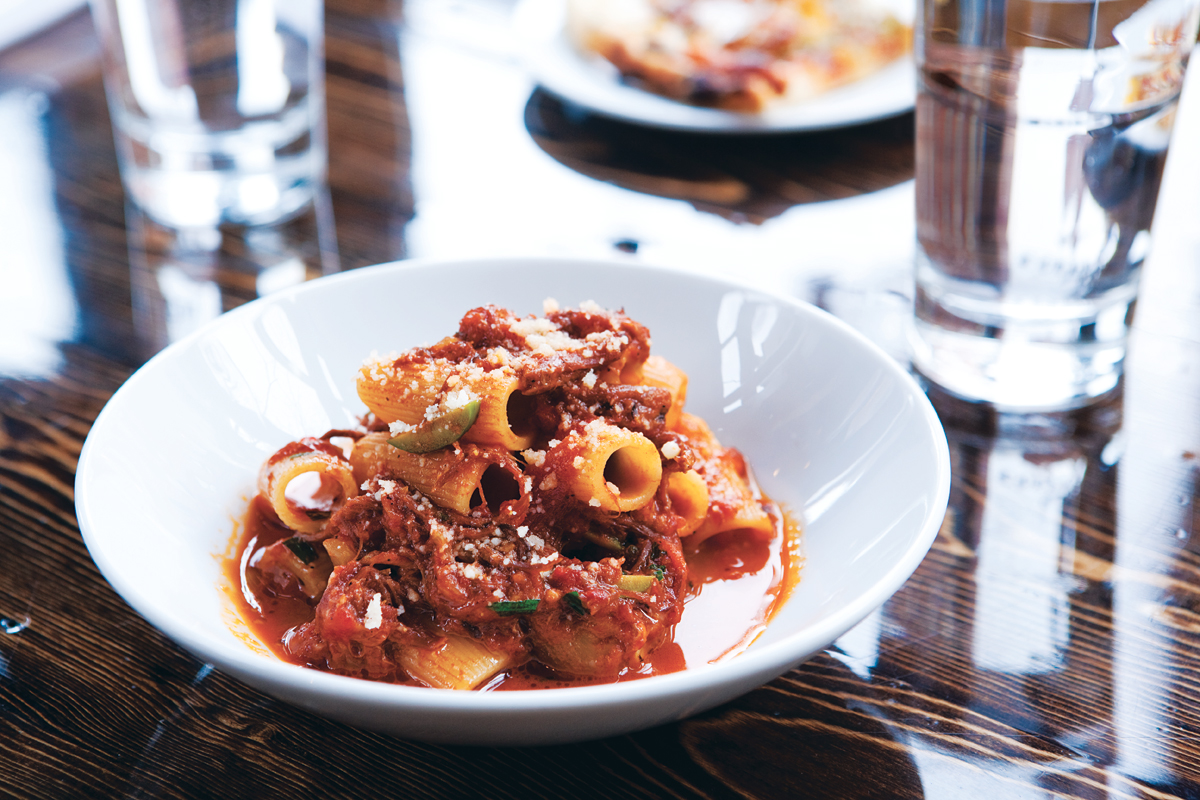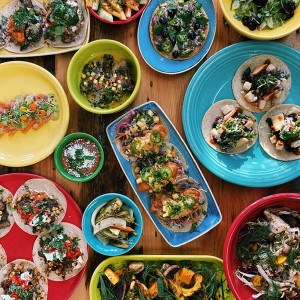Restaurant Review: Coppa in Boston

Photograph by Keller + Keller
Chefs Ken Oringer and Jaime Bissonnette are a potent team: The former brings culinary meticulousness, entrepreneurial ambition, front-of-house schmoozing, and wide-ranging tastes (as in, Barcelona to Japan); the latter boasts knockout cooking skills, particularly with meat. Together, they can do just about anything. The trouble is, they try to.
The amazing thing is how much they do well — really well — as the crowd at their South End tapas bar, Toro, proves every night. I’m often among the throng of diners there, and while I’ve got my own favorites memorized (virtually any dish grilled a la plancha), I also know that just about anything on Toro’s very long menu will be good. Consistency is the mark of a pro team.
And that’s what they’re working toward at Coppa, their white-hot South End enoteca that opened this past winter and immediately became the place everybody wanted to shoehorn into. The extensive menu has so many superb small plates (here Italian, not Spanish) that one wishes Coppa were as big as Toro — and perhaps had the same kind of breathing room to straighten out its opening kinks, since there’s plenty to work on here, including consistency problems as large as the menu itself. Still, Coppa is sorting things out, even under the glare of the spotlight.
Start with the meat. Coppa is Boston’s first truly snout-to-tail place (though Craigie on Main’s Tony Maws and even Bissonnette himself have been dabbling in the trend for a while), and pork fat, cartilage, gelatin, and offal are celebrated here. Bissonnette is no slouch at beef, either. The meatballs, part of the stuzzi menu (appetizers, all $5), are a fantastic dish: Made of short ribs, fat-filled pork belly, and trimmings from house-cured lardo, they’re pillowy and wonderfully spongy. And Bissonnette had the genius idea of veiling the meatballs with lardo just before they go into the wood-fired oven (Coppa’s magical, make-everything-better equivalent of Toro’s plancha). The result is a dish capable of muscling into the territory of reigning Italian pro Dante de Magistris, of Dante and Il Casale fame.
I was also impressed with the home-cured salumi (all $7). The lonza, or loin, is fabulously delicate and sweet, and the beef tongue is among the most expert I’ve ever had — very lightly smoked and salted, so you taste only the surprisingly lean meat. The duck “prosciutto” successfully avoids what Bissonnette calls the usual “plastic-y” quality of that small, hard-to-cure cut, resulting in fat that is almost as satisfactory, and as generous, as on a piece of jamón (though for pure, more highly spiced fat, have the lardo). Among the meaty highlights are the homemade sausages, which are vividly flavored — even, unusually, the chicken sausage, served with cavatelli ($12).
Be sure to order one of Coppa’s sensational pizzas (all $15), which come seasoned with plenty of experience: Oringer started at Al Forno in Providence, one of the spiritual homes of American pizza, while Bissonnette tossed pies in Hartford, where he trained at some of the many Italian restaurants in the area (and I know they’re good, because I grew up eating at them). Bissonnette has come up with a no-knead dough that’s just sturdy enough to support the huge, heavy pieces of meat and seafood — yes, that’s fried calamari! — heaped on top. It makes for hefty, knife-and-fork slices, even though the crust is pretty thin. I loved the one with roasted cauliflower, home-cured anchovies, béchamel, and Bra Duro cheese; the spicy pork sausage version (because Bissonnette is so good at sausage); and the Pepe’s-style white clam pizza with bacon and Vidalia onion, a tribute to the New Haven pizza shrine.
If you have the meatballs, a few plates of home-cured meats, and one of those wonderful pizzas, you’ll want to go through Coppa’s entire menu. Just be warned that, among the many other highs, there are a couple of heartbreaks, too. In sampling the salumi, I was not as taken with the bolognalike meats, particularly the namesake coppa di testa: Unappetizingly brown, it came off like salty, congealed hash. And I had wanted to like the homemade pastas (all $12), made with the fine Italian flour known as type 00, but they were gummy and dull, and overwhelmed by Bissonnette’s exuberant sauces. The lasagna was notably leaden, done in by perhaps the richest béchamel I’ve ever tasted; I’d rather have the meaty sauce on store-bought dried pasta.
In fact, I did enjoy the one dish made with dried pasta: rigatoni di capra, with a tasty wood-roasted goat ragu with mushrooms and green olives. And though both the orecchiette and the cavatelli were rubbery where they should have been merely resilient, they were redeemed by Bissonnette’s sausage (fennel in the orecchiette, chicken with the cavatelli). There was no saving grace, alas, for the spaghetti carbonara: a strange, slimy sea urchin–egg concoction, with practically no smoke from the smoked pancetta.
The thing is, I’m reaching. Yes, the use of garlic seemed a little hit and miss (as in, it was oddly absent from the pesto in a nice dish of trofie). Yes, the chicken Milanese was marvelously golden and crunchy-looking, and it all seemed fabulous…until the first, nearly flavorless bite. But it’s just crazy to get hung up on Coppa’s weaknesses. These are two dazzlingly skilled chef-restaurateurs having a great time trying out whatever they feel like. It may be a dish of tripe alla Romana, baked with squash, mozzarella, and tomato “gravy,” that turns out to be one of the best and most truly Roman dishes you’ll taste in this country, with exactly the right thin, peppery tomato sauce and lovingly cooked offal. Or it may be the pig’s tail — order it and you’ll get Coppa’s version of Momofuku’s-umami-fest pork belly, the nearly pure fat sweetened with mostarda.
All told, there’s not much that Oringer and Bissonnette can’t do (except maybe dessert — there isn’t any here, aside from gelato). I’d like Coppa to have a menu about one-third smaller and be in a space three times bigger, so I could get in more easily. But whatever it does, I want it to be around for a long time.
Coppa, 253 Shawmut Ave., Boston 617-391-0902, coppaboston.com


